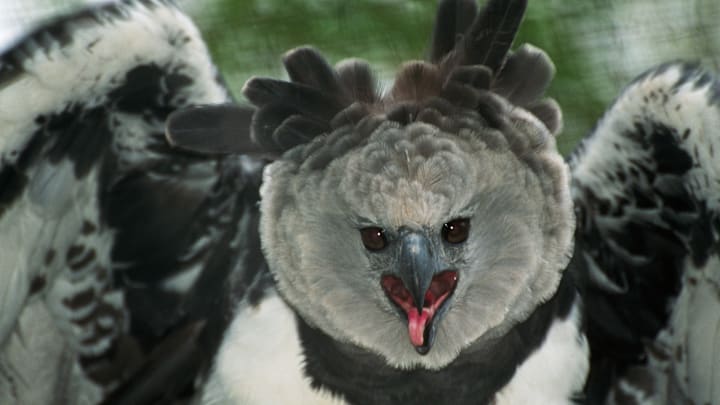You’d think the distinction of National Animal would bring with it some sort of benefit – protection from extinction, for instance. Not so. Take the bald eagle, symbol of these United States, which has been on and off the endangered species list for over 40 years. Sadly, this sort of thing is far from unusual. Here are six of the coolest, strangest, and most endangered animals repping countries today.
1. Belize – Baird’s Tapir (Tapirus bairdii)
With its stubby prehensile trunk, the Baird’s tapir isn’t the prettiest belle at the ball, but it is the biggest. At a max weight of 600 lbs, the tapir’s less-than-flattering colloquial name “Mountain Cow” refers to its bovine heft, though it is more closely related to the horse and the rhino. And like the rhino, the tapir is what scientists like to call a “living fossil” -- its features have hardly changed over millions of years of evolution. (Other so-called “living fossils”: the horseshoe crab, the cœlacanth, and the okapi – see below.) As the beast’s rainforest habitat disappears, however, adaptation might not be such a bad idea. Some researchers claim that certain populations in Belize have developed a taste for Wonder bread. That’s not gonna flatter the figure.
2. Democratic Republic of Congo – Okapi (Okapia johnstoni)
The okapi, the giraffe’s closest living relative, is like a shorter, stripier version of its cousin. Both evolved from the prehistoric paleotragus, or “ancient antelope” — though neither is a true antelope in any modern sense. After several thousand millenia keeping the ancient line alive, okapis have dwindled to the lower hundreds in recent years, due to poaching and armed conflict in the DRC. The okapi’s notorious skittishness has earned it comparison to the mythical unicorn, and rightfully so: The entire species managed to go unphotographed in the wild until 2008. The secretive creatures don’t even poop for the first 1-2 months of their lives, supposedly to avoid detection during the nesting phase.
3. Pakistan – Markhor (Capra falconeri)
Able to grow up to 240 lbs, this bad boy is the largest wild goat in the world -- as if that wasn’t obvious from the two iron-mining augers attached to his head. Its name resembles the Persian words “maar” (snake) and “khor” (eater), having earned it the misleading nickname, “snake-eating goat.” In truth, the markhor will eat a variety of things, mostly vegetable, and it is able to adapt quickly to ecological changes. Even so, it's no match for humans, who have hunted the markhor down to triple-digits. Hunting has been regulated in recent decades, but the almighty U.S. dollar can earn you a markhor head for your wall. Tens of thousands of U.S. dollars, actually, for a single snake eater.
4. Belarus – Wisent (Bison bonasus)
A taller, leaner European cousin of the American Bison, the wisent (awesomely called zoobr in Russian) has been equally used and abused. For centuries, Belarusians hunted wisent for their meat and decorative horns, and by the early 1900s wild wisent were effectively extinct – some say as few as 12 wisent remained in captivity. Over the next decades, that tiny group was systematically bred by noblemen, then scientists, and were reintroduced to their natural forest habitat during the 1950s. As one local legend has it, the most successful population of wild wisent currently lives in the area around Chernobyl, where nuclear fallout from the 1986 disaster has kept humans away, allowing wisent to thrive. The population continues to grow, though (like many royal families) it’s pretty inbred.
5. Panama – Harpy Eagle (Harpia harpyja)
The terrifyingly named Harpy Eagle has a wingspan of up to seven feet and talons that can grow as big as grizzly bear paws. It also has among the thickest tarsi relative to its body size, with relatively shorter wings for maneuvering around in the jungle, aaaand it can swoop at up to 50 mph. Basically, it could kick the red-white-and-blue out of a bald eagle, any day -- this thing literally eats sloths and monkeys for breakfast. Each nesting pair of harpy eagles requires about seven square miles of rainforest in which to hunt, so they're not exactly getting enough breakfast these days.
6. Mauritius – Dodo (Raphus cucullatus)
Mauritians love to celebrate the Dodo, which is weird because doing that is like celebrating extinction itself. After European explorers “discovered” the island nation in the 1600s, the Mauritian dodo was quickly killed off (eaten and pushed out by domesticated animals). A single head and a foot were the only remains of the beast available to science for 200 years. Dodo remains became the holy grail for scientists in Europe, especially for two rivals: Alfred Newton and Richard Owen — an early Darwinist and a staunch anti Darwinist, respectively. Owen managed to get his dodo fossils first, but in his haste, he misarranged the bones after the most famous painting of the dodo to date: the squat, rotund version that science had previously accepted. Though Owen later rearranged the bones accurately, his mistake of a dodo went down in history, bringing his name down with it. That’s gotta make you feel like a real...well, you know.
